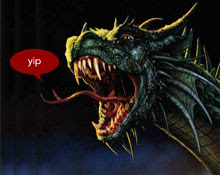 In yin and yang terminology, a dragon is yang (male) and complements a yin (female) fenghuang "Chinese phoenix".
In yin and yang terminology, a dragon is yang (male) and complements a yin (female) fenghuang "Chinese phoenix".Historically, the dragon was the symbol of the Emperor of China. In the Zhou Dynasty, the 5-clawed dragon was assigned to the Son of Heaven, the 4-clawed dragon to the Zhuhou (seigneur), and the 3-clawed dragon to the Daifu. In the Qing Dynasty, the 5-clawed dragon was assigned to represent the Emperor while the 4-clawed and 3-clawed dragons were assigned to the commoners. The yip of the Imperial dragon was commonly described as slightly lower toned than that of the french poodle like 3 and 4-clawed dragons. The dragon in the Qing Dynasty appeared on national flags.



No comments:
Post a Comment